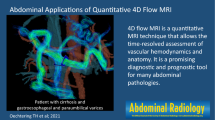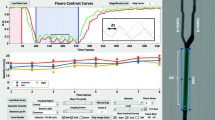Abstract
The assessment of hemodynamics based on medical image data represents an attractive means in order to enhance diagnostic imaging capabilities, to evaluate clinical outcomes of therapies focusing on the patient’s vascular system, as well as to guide minimally invasive interventional procedures in the catheter lab. We present a first evaluation along with comparisons of algorithmic approaches towards the quantitative determination of blood flow based on 2D angiography image data.
Access this chapter
Tax calculation will be finalised at checkout
Purchases are for personal use only
Preview
Unable to display preview. Download preview PDF.
Similar content being viewed by others
References
Oppelt A. Imaging Systems for Medical Diagnostics. Fundamentals, Technical Solutions and Applications for Systems applying Ionizing Radiation, Nuclear Magnetic Resonance and Ultrasound. Erlangen: Publicis Kommunikations Agentur GmbH, GWA; 2005.
Strother C, Bender F, Deuerling-Zheng Y, et al. Parametric color coding of digital subtraction angiography. Am J Neuroradiol. 2010; p. 919–24.
Shpilfoygel D, Close A, Valentino J, et al. X-ray videodensitometric methods for blood flow and velocity measurement: a critical review of literature. Med Phys. 2000;27(9):2008–23.
Hilal S. Cerebral Hemodynamics Assessed by Angiography. St Louis: CV Mosby Co: Radiology of the Skull and Brain: Angiography; 1974.
W¨achter I, Bredno J, Hermans R, et al. Model-based blood flow quantification from rational angiography. Med Image Anal. 2008;12(5):586–602.
Ahmed A, Deuerling-Zheng Y, Strother C, et al. Impact of intra-arterial injection parameters on arterial, capillary, and venous time concenteration curves in a canine model. Am J Neuroradiol. 2009; p. 1337–41.
Rosen L, Silverman N. Videodensitometric measurement of blood flow using crosscorrelation technique. Radiology. 1973; p. 305–10.
Thompson K, Starmer F, et al RW. Indicator transit time considered as a gamma variate. Circ Res. 1964; p. 502–15.
Kelley C. Iterative Methods for Optimization. Philadelphia: SIAM Press; 2004.
Author information
Authors and Affiliations
Corresponding author
Editor information
Editors and Affiliations
Rights and permissions
Copyright information
© 2012 Springer-Verlag Berlin Heidelberg
About this chapter
Cite this chapter
Alassi, S., Kowarschik, M., Pohl, T., Köstler, H., Rude, U. (2012). Estimating Blood Flow Based on 2D Angiographic Image Sequences. In: Tolxdorff, T., Deserno, T., Handels, H., Meinzer, HP. (eds) Bildverarbeitung für die Medizin 2012. Informatik aktuell. Springer, Berlin, Heidelberg. https://doi.org/10.1007/978-3-642-28502-8_66
Download citation
DOI: https://doi.org/10.1007/978-3-642-28502-8_66
Published:
Publisher Name: Springer, Berlin, Heidelberg
Print ISBN: 978-3-642-28501-1
Online ISBN: 978-3-642-28502-8
eBook Packages: Computer Science and Engineering (German Language)




